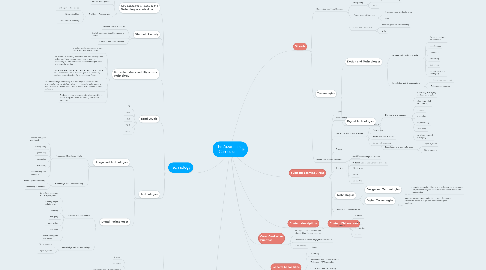
1. Cross Curriculum Priorities
1.1. Aboriginal and Torres Straight Islander histories and cultures
1.2. Asia and Australia's engagement with Asia
1.3. Sustainability
2. Technology
2.1. Key concepts & ideas in the Technologies curriculum
2.1.1. Creating preferred futures
2.1.2. Project management
2.1.3. Thinking in Technologies
2.1.3.1. Thinking in Technologies
2.1.3.2. Design thinking
2.1.3.3. Computational thinking
2.2. Student Diversity
2.2.1. Students with a disability
2.2.2. English as an additional Language or dialect
2.2.3. Gifted and talented Students
2.3. Curriculum Aims and Objectives: Technology
2.3.1. Investigate, design, plan, manage, create and evaluate solutions
2.3.2. Students are creative, innovative and enterprising when using traditional, contemporary and emerging technologies, and understand how technologies have developed over time
2.3.3. Students make informed and ethical decisions about the role, impact and use of technologies in the economy, environment and society for a sustainable future
2.3.4. Students engage confidently with and responsibly select and manipulate appropriate technologies − materials, data, systems, components, tools and equipment − when designing and creating solutions
2.3.5. Students critique, analyse and evaluate problems, needs or opportunities to identify and create solutions.
2.4. Band Levels-
2.4.1. F-2
2.4.2. 3 & 4
2.4.3. 5 & 6
2.4.4. 7 & 8
2.4.5. 9 & 10
2.5. Technologies
2.5.1. Design and Technologies
2.5.1.1. Process and Production Skills
2.5.1.1.1. Creating designed solutions by:
2.5.1.1.2. investigating
2.5.1.1.3. generating
2.5.1.1.4. producing
2.5.1.1.5. evaluating
2.5.1.1.6. collaborating and managing
2.5.1.2. Knowledge and Understanding
2.5.1.2.1. Technologies and society
2.5.1.2.2. Technologies contexts
2.5.2. Digital Technologies
2.5.2.1. Process and production
2.5.2.1.1. Collecting, managing and analysing data
2.5.2.1.2. Creating digital solutions by:
2.5.2.1.3. defining
2.5.2.1.4. designing
2.5.2.1.5. implementing
2.5.2.1.6. evaluating
2.5.2.1.7. collaborating and managing
2.5.2.2. Knowledge and Understanding
2.5.2.2.1. Digital systems
2.5.2.2.2. Digital systems
2.6. General Capabilities
2.6.1. Literacy
2.6.2. Numeracy
2.6.3. Information and Communication Technology (ICT) capability
2.6.4. Critical and Creative Thinking
2.6.5. Personal and Social Capability
2.6.6. Ethical Understanding
2.6.7. Intercultural Understanding
2.7. Cross Curriculum Priorities
2.7.1. Aboriginal and Torres Straight Islander histories and cultures
2.7.2. Asia and Australia's engagement with Asia
2.7.3. Sustainability
2.8. Content descriptor, Elaborations and achievement Standards
2.8.1. Content descriptor
2.8.1.1. What needs to be taught
2.8.2. Content elaborations
2.8.2.1. Expands on the descriptor
2.8.3. Achievement standards
2.8.3.1. What students need to achieve by the end of each band
3. Content descriptions
3.1. Content Elaborations
4. Subjects: Learning Areas
4.1. English
4.2. Mathematics
4.3. Humanities and Social Sciences
4.3.1. History
4.3.2. Geography
4.3.3. Economics and Business
4.3.4. Civics and citizenship
4.4. Science
4.5. The Arts
4.5.1. Dance
4.5.2. Drama
4.5.3. Media Arts
4.5.4. Music
4.5.5. Visual Arts
4.6. Technologies
4.6.1. Design and Technologies
4.6.1.1. students use design thinking and technologies to generate and produce designed solutions for authentic needs and opportunities
4.6.2. Digital Technologies
4.6.2.1. students use computational thinking and information systems to define, design and implement digital solutions
4.7. Health and Physical Education
4.8. Languages
4.8.1. Chinese
4.8.2. French
4.8.3. Indonesian
4.8.4. Italian
5. General Capabilities
5.1. Literacy
5.2. Numeracy
5.3. Information and Communication Technology (ICT) capability
5.4. Critical and Creative Thinking
5.5. Personal and Social Capability
5.6. Ethical Understanding
5.7. Intercultural Understanding
6. Cross Curriculum Priorities
6.1. Aboriginal and Torres Straight Islander histories and cultures
6.2. Asia and Australia's engagement with Asia
6.3. Sustainability
7. Strands
7.1. English
7.1.1. Language
7.1.2. Literature
7.1.3. Literacy
7.2. Mathematics
7.2.1. Number and Algerbra
7.2.2. Measurement and Geometry
7.2.3. Statistics and probability
7.3. Science
7.3.1. Science Understanding
7.3.2. Science as a Human Endeavour
7.3.3. Science Inquiry Skills
7.4. Humanities and Social Sciences
7.4.1. History
7.4.1.1. Knowledge and Understanding
7.4.1.2. Skills
7.4.2. Geography
7.4.2.1. Knowledge and Undrestanding
7.4.2.2. Skills
7.4.3. Economics and Business
7.4.3.1. Knowledge and Understanding
7.4.3.2. Skills
7.4.4. Civics ans Citizenship
7.4.4.1. Knowledge and Undrestanding
7.4.4.2. Skills
7.5. Technologies
7.5.1. Design and Technologies
7.5.1.1. Process and Production Skills
7.5.1.1.1. Creating designed solutions by:
7.5.1.1.2. investigating
7.5.1.1.3. generating
7.5.1.1.4. producing
7.5.1.1.5. evaluating
7.5.1.1.6. collaborating and managing
7.5.1.2. Knowledge and Understanding
7.5.1.2.1. Technologies and society
7.5.1.2.2. Technologies contexts
7.5.2. Digital Technologies
7.5.2.1. Process and production
7.5.2.1.1. Collecting, managing and analysing data
7.5.2.1.2. Creating digital solutions by:
7.5.2.1.3. defining
7.5.2.1.4. designing
7.5.2.1.5. implementing
7.5.2.1.6. evaluating
7.5.2.1.7. collaborating and managing
7.5.2.2. Knowledge and Understanding
7.5.2.2.1. Digital systems
7.5.2.2.2. Digital systems
7.6. Health and Physical Education
7.6.1. Movement and Physical Acticity
7.6.2. Personal, Social and Community Health
